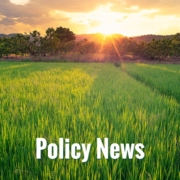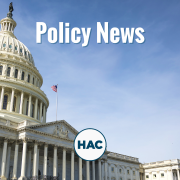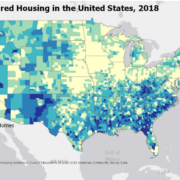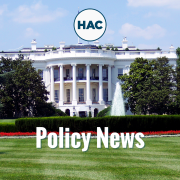Information on FY22 HUD funding
UPDATE March 11, 2022 – Both the House and Senate have passed the omnibus bill and President Biden will sign it into law, avoiding a government shutdown and funding federal programs through fiscal year 2022, which ends on September 30, 2022.
March 9, 2022 – Several USDA rural housing programs will receive modest funding increases in the omnibus appropriations bill for fiscal year 2022. The bill’s text, released overnight, does not include the significant boosts for rental housing that were included in House and/or Senate versions, instead compromising on smaller raises.
The bill expands eligibility for Section 542 vouchers, which have previously been available only to tenants living in Section 515 properties where the mortgage has been prepaid since September 30, 2005. This language is revised to apply to tenants in properties where Section 515 loans are “prepaid or otherwise paid off after September 30, 2005″ (emphasis added), potentially extending eligibility to tenants of every property that has left the portfolio since that date. USDA could set some limits on this expansion, as it has for tenants in properties with prepaid mortgages, who can obtain vouchers only if they live in the property on the date the prepayment occurs.
Other provisions in the final bill are retained from past appropriations measures. These include language allowing rental property owners to request 20-year Rental Assistance contracts, subject to appropriations. The bill also retains provisions calling for incentives to nonprofits to preserve rental housing, reuse of recaptured Section 521 Rental Assistance (RA), and use of recaptured RA from farmworker housing in other farmworker housing when possible.
The bill continues the 10-20-30 requirement that at least 10 percent of most USDA Rural Development programs, including most housing programs, be set aside for persistent poverty counties (counties where the poverty rate has been at least 20 percent for 30 years).
The omnibus establishes one new program related to rural housing and community development: an Institute for Rural Partnerships, which “shall dedicate resources to researching the causes and conditions of challenges facing rural areas, and develop community partnerships to address such challenges.” The institute will be housed at the University of Vermont and three land-grant universities to be selected by USDA. Each institution will receive a $10 million grant.
The continuing resolution that currently funds the federal government ends at midnight on March 11. The House is expected to pass the omnibus bill on March 9. Another continuing resolution, lasting just a few days, may be needed to give the Senate enough time to act.
| USDA Rural Dev. Prog.
(dollars in millions) |
FY20 Final Approp. |
FY21 Final Approp. |
Amer. Rescue Plan Act |
FY22 Admin. Budget |
FY22 House Bill |
FY22 Senate Bill |
FY22 Final |
| 502 Single Fam. Direct |
$1,000 |
$1,000 |
$656.6a |
$1,500 |
$1,500 |
$1,250 |
$1,250 |
| 502 Single Family Guar. |
24,000 |
24,000 |
– |
30,000 |
30,000 |
30,000 |
30,000 |
| 504 VLI Repair Loans |
28 |
28 |
18.3a |
28 |
28 |
28 |
28 |
| 504 VLI Repair Grants |
30 |
30 |
– |
30 |
40 |
30 |
32 |
| 515 Rental Hsg. Direct Lns. |
40 |
40 |
– |
40 |
40 |
92 |
50 |
| 514 Farm Labor Hsg. Lns. |
28 |
28 |
– |
28 |
28 |
28 |
28 |
| 516 Farm Labor Hsg. Grts. |
10 |
10 |
– |
10 |
15 |
10 |
10 |
| 521 Rental Assistance |
1,375 |
1,410 |
100 |
1,450 |
1,450 |
1,450 |
1,450 |
| 523 Self-Help TA |
31 |
31 |
– |
32 |
32 |
32 |
32 |
| 533 Hsg. Prsrv. Grants |
15 |
15 |
– |
15 |
25 |
15 |
16 |
| 538 Rental Hsg. Guar. |
230 |
230 |
– |
230 |
230 |
250 |
250 |
| Rental Prsrv. Demo. (MPR) |
28 |
28 |
– |
32 |
60 |
32 |
34 |
| 542 Rural Hsg. Vouchers |
32 |
40 |
– |
45 |
45 |
45 |
45 |
| Rental Prsrv. TA |
1 |
2 |
– |
0 |
2 |
2 |
2 |
| Rural Cmnty. Dev’t Init. |
4 |
6 |
– |
6 |
6 |
6 |
6 |
a. The American Rescue Plan Act of 2021 provides $39 million in budget authority to refinance Section 502 direct loans and Section 504 loans for homeowners impacted by the coronavirus pandemic. USDA expects this funding to generate $656.6 million in Section 502 direct loans and $18.3 million in Section 504 loans.
August 5, 2021 – The Senate Appropriations Committee passed its FY22 USDA funding bill on August 4. While the House bill proposes a substantial increase in funding for the Multifamily Preservation and Revitalization program, the Senate bill would increase Section 515 funding rather than MPR. The Senate bill suggests increases in some other programs, but most of its figures are lower than the House’s.
The Senate bill would retain a provision in FY21 appropriations law, dropped by the administration’s budget and the House, that allows rental property owners to request 20-year terms for Rental Assistance contracts, subject to annual appropriations. The Senate and House would both keep provisions calling for incentives to nonprofits to preserve rental housing, reuse of recaptured Rental Assistance (RA), and use of recaptured RA from farmworker housing in other farmworker housing when possible, although those were left out of the administration’s budget request.
July 27, 2021 – The House passed H.R. 4502, a “minibus” package of seven appropriations bills, including USDA’s (see table below) and HUD’s.
July 1, 2021 – The full House Appropriations Committee approved its FY22 USDA funding bill on June 30, including increases in some rural housing programs as described below. The bill will be considered later this summer by the full House. The Senate has not yet released a proposal.
The House committee also released its report on the bill, providing additional information and directives from the committee, including a paragraph about farmworker housing.
Farm Labor Housing.—The Committee encourages USDA to explore opportunities to leverage its resources including its Food and Nutrition Programs, Community Facilities Programs, Housing Preservation Grants, and other programs, and to create partnerships with the Department of Labor’s Farmworker Housing outreach and technical assistance program, Health Resources and Services Administration’s Health Center Program, and the Administration for Children and Families Migrant and Seasonal Head Start Program, to coordinate and align resources to address the housing, nutrition and healthcare needs of this vulnerable population of essential workers who play a critical role in America’s food security. The Committee further encourages USDA to explore including service coordinators as an allowable expenditure for farm labor housing projects.
June 24, 2021 – As congressional action begins for fiscal year 2022 federal funding, the House Appropriations Committee has released a bill proposing increases in several of USDA’s rural housing programs.
Like the administration’s budget, the House bill would raise funding for Section 502 direct and guaranteed mortgage loans, Rental Assistance, and self-help housing. While the budget would increase the Multifamily Preservation and Revitalization (MPR) program to $32 million from $28 million in FY21, the House bill would provide a far larger boost, to $65 million. The House would also grow the Section 504 grant program for elderly low-income homeowners and the Section 533 Housing Preservation Grants program.
The House bill retains several provisions that are in current appropriations law but were dropped in the administration’s budget. These call for incentives to nonprofits to preserve rental housing, reuse of recaptured Rental Assistance (RA), and use of recaptured RA from farmworker housing in other farmworker housing when possible. Like the budget, however, it eliminates a provision from the FY20 and FY21 appropriations laws that allowed property owners to request RA contracts with 20-year terms.
The House Agriculture Appropriations Subcommittee will review the draft bill at a mark-up on June 25, 2021. The full House Appropriations Committee will consider it on June 30. The Senate has not yet begun its appropriations process.
| USDA Rural Dev. Prog.
(dollars in millions) |
FY20 Final Approp. |
FY21 Final Approp. |
Amer. Rescue Plan Act |
FY22 Admin. Budget |
FY22 House Bill |
| 502 Single Fam. Direct |
$1,000 |
$1,000 |
$656.6a |
$1,500 |
$1,500 |
| 502 Single Family Guar. |
24,000 |
24,000 |
– |
30,000 |
30,000 |
| 504 VLI Repair Loans |
28 |
28 |
18.3a |
28 |
28 |
| 504 VLI Repair Grants |
30 |
30 |
– |
30 |
c |
| 515 Rental Hsg. Direct Lns. |
40 |
40 |
– |
40 |
40 |
| 514 Farm Labor Hsg. Lns. |
28 |
28 |
– |
28 |
b |
| 516 Farm Labor Hsg. Grts. |
10 |
10 |
– |
10 |
b |
| 521 Rental Assistance |
1,375 |
1,410 |
100 |
1,450 |
1,450 |
| 523 Self-Help TA |
31 |
31 |
– |
32 |
32 |
| 533 Hsg. Prsrv. Grants |
15 |
15 |
– |
15 |
c |
| 538 Rental Hsg. Guar. |
230 |
230 |
– |
230 |
230 |
| Rental Prsrv. Demo. (MPR) |
28 |
28 |
– |
32 |
60 |
| 542 Rural Hsg. Vouchers |
32 |
40 |
– |
45 |
45 |
| Rental Prsrv. TA |
1 |
2 |
– |
0 |
2 |
| Rural Cmnty. Dev’t Init. |
4 |
6 |
– |
6 |
6 |
a. The American Rescue Plan Act of 2021 provides $39 million in budget authority to refinance Section 502 direct loans and Section 504 loans for homeowners impacted by the coronavirus pandemic. USDA expects this funding to generate $656.6 million in Section 502 direct loans and $18.3 million in Section 504 loans.
b. The House bill provides a total of $17.8 million in budget authority for the Section 514 and 516 farm labor housing programs. When the Appropriations Committee prepares a report on the bill, that document will state the program amounts.
c. The House bill provides a total of $65 million for Section 504 grants and Section 533 grants. When the Appropriations Committee prepares a report on the bill, that document will show how the total is to be divided between the two programs.






